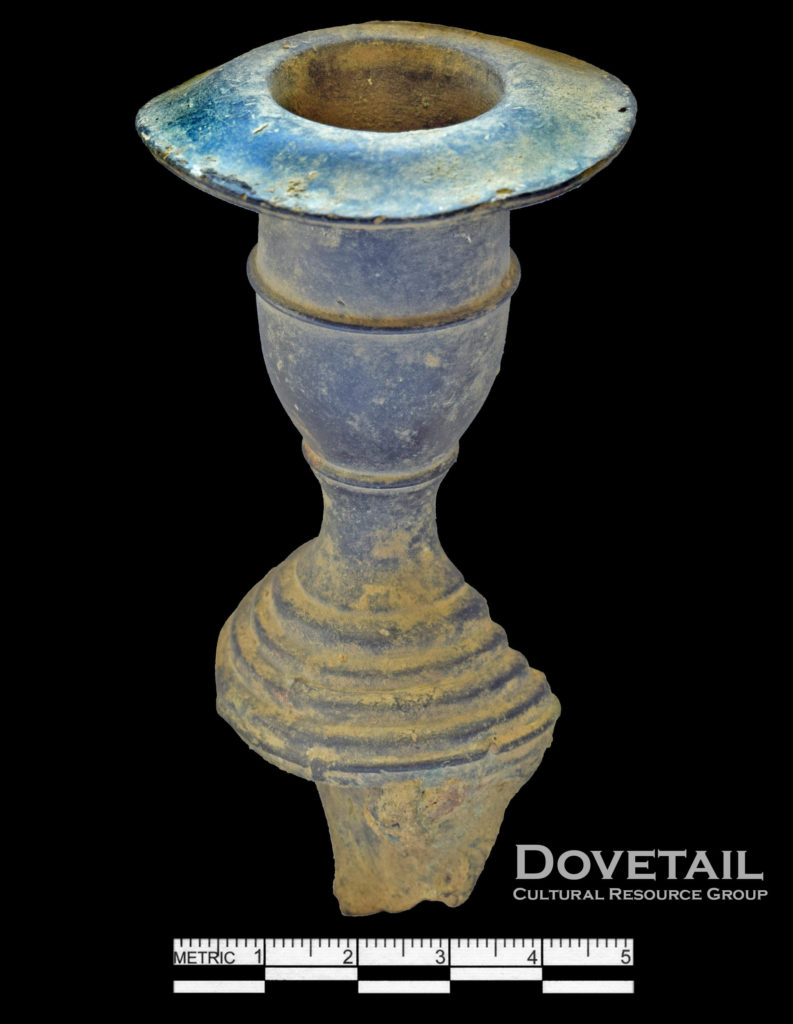By Kerry S. González and D. Brad Hatch
This month we are once again highlighting an artifact recovered from our Riverfront Park excavations in Fredericksburg, Virginia. The candlestick fragment pictured below is made of brass and is typical of the late Georgian/early Federal style, popular in the late-eighteenth century. This particular candlestick has been dated to circa 1795.
It is no surprise to read that candlesticks have been used for millenia with the sole purpose of holding a candle. According to Geoffrey Wills (1974) in his book Candlesticks: “a prudent eighteenth-century lady, Mrs. Whatman, noted that the first thing a housekeeper should teach her new servant is to carry her candle upright.” While the Romans are credited with creating the wicked candle, other civilizations were using similar styles of lighting for daily use or ceremonial purposes years before (candles.org 2019). These early forms of the candlestick eventually evolved into very elaborate items often made of precious metals such as gold or silver. These expensive pieces were a sign a wealth for the upper class and were used as status symbols as much as they were for lighting.
However, candles and candlesticks were not only used for lighting. During the seventeenth century the sport of ‘candle jumping’ was quite popular and often practiced at festivals (nurseryrhymesforbabies.com 2019). It reportedly involved a young girl jumping over a lit candle with the intention of trying not to extinguish the flame (nurseryrhymesforbabies.com 2019). Candles have also played a significant role in popular culture through the ages due to their ubiquity in society, particulary before the advent of electricity. The popular nursery rhyme “Jack Be Nimble” features candle jumping and may have originated as early as the seventeenth century, in relation to the sport. The continued popularity of this rhyme helps to underscore the importance of this object in society. Indeed many people still decorate their homes with candlesticks, though their function as lighting devices has declined over the past century. Nevertheless, these familiar objects are able to provide us with important information on the lifeways of people in the past, including those that lived on and near the Riverfront site in eighteenth- and nineteenth-century Fredericksburg. Recovering such an embellished object from a Fredericksburg home speaks to the possible affluence of the owner and consumer practices in our early port town.

Photo 2: Candle Recovered from Dovetail Excavations Beside a Complete Candlestick of the Same Style and Form (Antiques.com 2019).
References:
Antiques.com
2019 Pair of Georgian Brass Candlesticks, c. 1785. Electronic document, https://www.antiques.com/classified/Decorative-Interior/Antique-Candlesticks—Holders/Antique-Pair-of-Georgian-brass-candlesticks–C–1785?fbclid=IwAR1VbZoWa9fLSH2FjT0e7uwnAH0h3ZRfXE0NfrlKn-bLz82Rsri8QaLZeGI, accessed May 2019.
Nurseryrhymesforbabies.com
2019 The History of Jack Be Nimble. Electronic document, nurseryrhymesforbabies.com, accessed May 2019.
Wills, Geoffrey
1974 Candlesticks. Clarkson N. Potter, Inc./Publisher. New York, New York.
Any distributions of blog content, including text or images, should reference this blog in full citation. Data contained herein is the property of Dovetail Cultural Resource Group and its affiliates.

